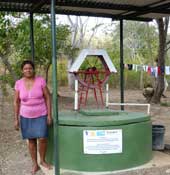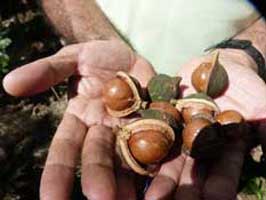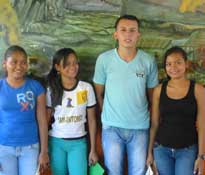SHEAF/ESPIGA Highlights 2023
With COVID restrictions no longer impeding travel, three board members and two friends of SHEAF/ESPIGA travelled to Nicaragua. Two of these went to the East Coast to see our partners in Siksayari.
Nicaragua, like other countries, are recovering from the effects of COVID. We were hoping to sense some optimism, more jobs, more tourists, a boost in the economy. Instead, we heard seniors had lost a portion of their income and that a lot of young people had decided to attempt to take the perilous trip to the United States or Canada, legally or illegally. Some of them had sold everything they had for the trip only to be forced back with less than when they started. One of our partners, The Institute for Promotion of Humanity (INPHRU), believes the situation to be dire enough to start reaching out to young people, inviting them to workshops explaining the reality of trying to immigrate and the hardships that they will face. They also were picking up the pieces of those who had tried to leave but were unsuccessful.
The paperwork the government demands of our partners and external NGO has become onerous. But if not completed properly, the appropriate small levy unpaid, their bank accounts can be frozen and with the case of foreign NGO’s, they can be kicked out of the country which has happened to more than 200 of them.
Nevertheless. Nicaraguans and SHEAF/ESPIGA are resilient: we soldier on.
Overview of Current Projects
Quality Seeds

We were delighted to see that the seed project SHEAF/ESPIGA began to support last year through our partner the ACJ (YMCA) was continuing well. The project started with of a group of small farmers, in the Camoapa/Boaco region and has been expanded to another community. The Leon farmers ar e working on improving the indigenous corn and bean seeds – seeds suitable for the region and local growing conditions. By saving seeds from the hardiest plants until the next planting season, they can repeat the process – saving and improving on the best and subsequently greening the local hillsides with these better adapted seeds.
e working on improving the indigenous corn and bean seeds – seeds suitable for the region and local growing conditions. By saving seeds from the hardiest plants until the next planting season, they can repeat the process – saving and improving on the best and subsequently greening the local hillsides with these better adapted seeds.
The pictures show the mini-silos that house the seeds and a field planted with these selected seeds.
The Village of Sixsayari on the Rio Coco
This year, a Board member and a friend of SHEAF/ESPIGA made the perilous 12 hour motor boat journey including dodging rapids to spend a week in the community of Sikasyari. They observed the impressive advances the community has made. In the past, we supported their efforts t o increase rice production and to diversify the crops, from the traditional crops of corn and beans to include bananas, avocados and cocoa. All these crops are now growing in these areas. Rice, corn and beans provide immediate food security and harvests from the other crops will augment the diet. Moreover, they hope to gain a profit in a few years from the sales of cocoa.
o increase rice production and to diversify the crops, from the traditional crops of corn and beans to include bananas, avocados and cocoa. All these crops are now growing in these areas. Rice, corn and beans provide immediate food security and harvests from the other crops will augment the diet. Moreover, they hope to gain a profit in a few years from the sales of cocoa.
The board member was honoured to be able to watch a rigorous soccer match when an enthusiastic team from a neighbouring village (8 km.away over a very rough jungle trail (of sorts)) challenged the local team. The local team triumphed, and, in an impressive sign of solidarity and generosity, shared some of the sports equipment which SHEAF/ESPIGA had provided.
Subsequently, the friend of SHEAF/ESPIGA (and physically fit) Canadian visitor hiked into the village from which the visiting team had come. He returned 10 hours later, completely exhausted. The local youth had walked to Sixsayari, played two tough matches and, as night  fell, happily set out to return!
fell, happily set out to return!
We are also pleased to continue to supply medicines for the clinic.
So, as we have continued to support the community we build on firm foundations and are privileged to work alongside committed people who work and play hard together.
Education and Culture
Education
This year, the first Clifford Ellis scholarships were presented to four students in Chaguitillo studying in p ost secondary institutions. Cliff was a University of Guelph professor who visited Chaguitillo before the scholarship fund was established. He was impressed with the resilience of the people in Chaguitillo who worked together in an organized manner to help their children get through high school and if academically suited achieve a post secondary education. His widow has funded the scholarships. The scholarsh
ost secondary institutions. Cliff was a University of Guelph professor who visited Chaguitillo before the scholarship fund was established. He was impressed with the resilience of the people in Chaguitillo who worked together in an organized manner to help their children get through high school and if academically suited achieve a post secondary education. His widow has funded the scholarships. The scholarsh ip is augmented by a stipend by a board member in memory of his son, Andre. We are still impressed with the resilience of the community and their dedication to their young people.
ip is augmented by a stipend by a board member in memory of his son, Andre. We are still impressed with the resilience of the community and their dedication to their young people.
We visited two very rural schools to meet high school students who were recipients of a SHEAF/ESPIGA scholarship. These high school students only attend school on Saturdays. They work during the week, usually on family farms. On week days, primary students attend the school. In this photo they are lined up for a free lunch with is provided to them by the community. Some of these students travel a long distance to school, leaving home very early to arrive on time for the beginning of school at 8 o’clock.
Culture:

 It is always a joy to visit the Batahola Cultural Centre in Managua. The centre assists the art and music program which neighbourhood children attend at no cost. Enthusiastic participants have even played at the Ruben Dario National Theatre. The centre helps students from this poor barrio dream big and escape to a world of art for a few hours each week.
It is always a joy to visit the Batahola Cultural Centre in Managua. The centre assists the art and music program which neighbourhood children attend at no cost. Enthusiastic participants have even played at the Ruben Dario National Theatre. The centre helps students from this poor barrio dream big and escape to a world of art for a few hours each week.
One of the leaders is shown with a student who came to the centre as a child. She suggests it is the centre who kept her focussed on school, on homework and social stability. She now feels ready for university and attributes her readiness to the support and help she received from the centre.




